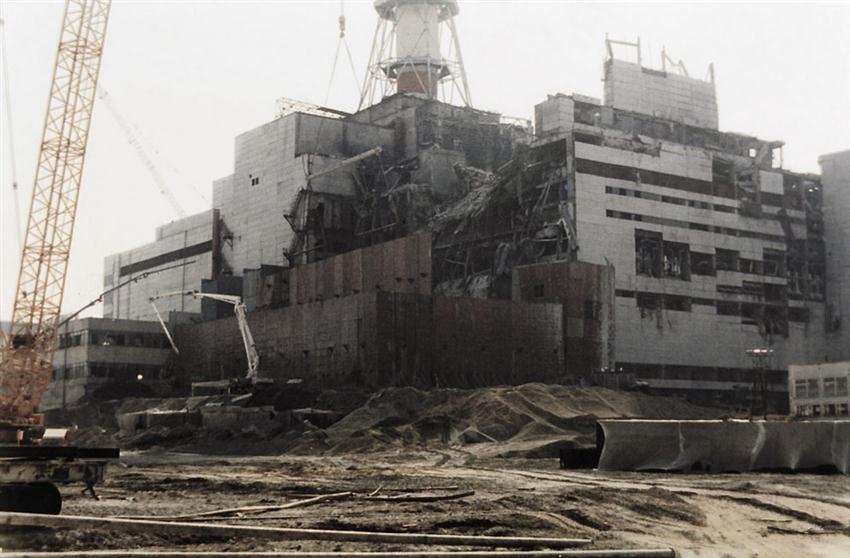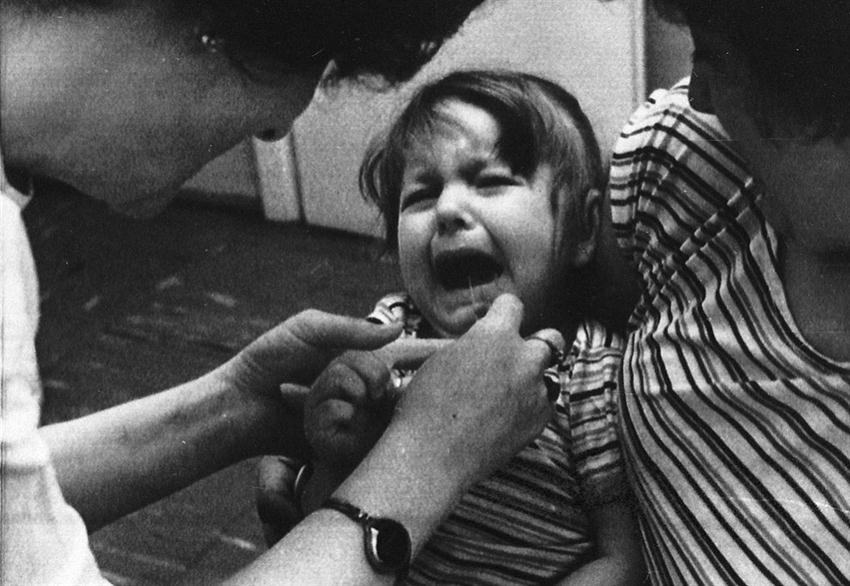"Post from the
past": Today, April 26, celebrated 26 years since the Chernobyl
disaster. In 1986, the Chernobyl reactor number 4 explosion, and several
hundred workers and firefighters were trying to put out a fire that burned 10
days. Radiation cloud enveloped the world, it was the worst nuclear
disaster in the world. Then killed about 50 people and damaged hundreds of
stations rescuers. Determine the magnitude of the disaster and its impact
on human health is still hard - only to cancer that developed as a result of
the administered dose of radiation, died from 4 to 200 thousand
people. Earlier this year, the Ukrainian government announced that is
going to narrow the range to which tourists can approach the site of the
Chernobyl nuclear power plant. Meanwhile, it is expected that the steel
body called the New Safe Confinement weighing 20,000 tons, will be completed by
2013.
1. Military helicopter conducting decontamination and
decontamination of the area around the Chernobyl nuclear power plant, a few
days after the explosion at reactor number 4. (STF / AFP / Getty Images)
2. Aerial view of the Chernobyl nuclear power plant,
where there was the largest man-made disaster of the 20th century, in April
1986. Front of the tube - the destroyed fourth reactor. Over the
chimney and is very close to the fourth reactor was the third reactor, which
stopped work on December 6, 2000. (AP Photo)
3. Repairs at the Chernobyl nuclear power plant in
Ukraine, October 1, 1986 after the largest explosion in April, because of which
affected 3,235,984 Ukrainians, and the radioactive cloud enveloped much of
Europe. (ZUFAROV / AFP / Getty Images)
4. Part of the roof collapsed at the Chernobyl nuclear
power plant after a fire Oct. 13, 1991. (AP Photo / Efrm Lucasky)
5. Lieutenant Colonel Leonid Telyatnikov, the head of
Pripyat Fire Brigade that fought the fire at the Chernobyl nuclear power plant,
points to a photo of the fourth reactor after an explosion April 26,
1986. The reactor was then filled with cement. Telyatnikov
36-year-old was ospitalized for two months with acute radiation sickness. He
was twice decorated for bravery, was awarded the title Hero of the
USSR. (Reuters)
6. Repair work at the Chernobyl Nuclear Power Plant
Aug. 5, 1986. (ZUFAROV / AFP / Getty Images)
7. An employee of the Institute of Atomic
Energy. Kurchatov in the sun-drenched cement flow into the room after the
Chernobyl nuclear reactor explosion September 15, 1989, three years after the
disaster. (AP Photo / Mikhail Metzel)
8. Chernobyl nuclear power plant worker checks the
radiation level in the engine compartment of the first and second energy unit 5
June 1986. (Reuters)
9. Cemetery irradiated equipment near the Chernobyl
nuclear power plant 10 November 2000. About 1,350 Soviet military
helicopters, buses, bulldozers, tankers, transporters, fire engines and
ambulances were used to combat the effects of man-made disaster in
Chernobyl. All were irradiated during cleaning operations. (AP Photo
/ Efrem Lukatsky)
10. An employee of the Institute of Atomic
Energy. Kurchatov mechanics in the room in the block № 4 September 15,
1989. (AP Photo / Mikhail Metzel)
11. Warsaw hospital nurse tries to put drops of iodine
solution is a three-year girl in May 1986. After the disaster at Chernobyl
in many neighboring countries have taken every possible measure against a
possible radiation damage. (AP Photo / Czarek Sokolowski)
12. Concrete at the site where the manufactured
concrete sarcophagus, at the fourth reactor in October 1986. (Reuters)
13. The representative of the Ukrainian Academy of
Sciences Vyacheslav Konovalov stuffed with mutated colt in Zhytomyr, March 11,
1996. Konovalov studying biological mutations after the explosion at the
Chernobyl nuclear power plant. Stallion nicknamed "Gorbachev"
after Konovalov brought a picture of the poor animal's overall growth in the
Supreme Council in 1988, Mikhail Gorbachev, to show the effects of the
disaster. (AP Photo / Efrem Lukatsky)
14. Vladimir Lenin statue in a small park at the port
of Chernobyl, near the frozen river Pripyat January 29, 2006. Port of
Chernobyl was abandoned shortly after the crash of 1986. (Daniel Berehulak
/ Getty Images)
15. General view of the Chernobyl nuclear power plant
April 26, 1986. (Reuters / Mykola Lazarenko)
16. The screen of the control unit first energy room at
the Chernobyl nuclear power plant, which has the process of unloading the last
batch of nuclear fuel from the reactor 30 November 2006. (SERGEI SUPINSKY
/ AFP / Getty Images)
17. Raven on the sign "Radiation danger" in the
30-km exclusion zone around the Chernobyl nuclear power plant near the village
Babchin, Belarus December 23,
2009. (Reuters / Vasily Fedosenko)
18. Ukrainian students wear masks during a training
exercise at school not far from exclusion zone April 3, 2006. (AP Photo /
Oded Balilty)
19. View of Chernobyl nuclear power plant from the ghost
town of Pripyat April 13,
2006. (Reuters / Gleb Garanich)
20. Ferris wheel in the ghost town of Pripyat which was
evacuated after the explosion. (Reuters / Gleb Garanich)
21. Cribs in a hospital in the deserted town of
Pripyat, in the exclusion zone around the closed Chernobyl nuclear power plant,
April 2, 2006. Pripyat town with a population of 47,000 people was
completely evacuated within a few days after the incident. (AP Photo /
Oded Balilty)
22. General view of the city of Pripyat April 13,
2006. (Reuters / Gleb Garanich)
23. Guide dosimeter in which the radiation level is 12
times higher than normal. The girl photographed behind concrete
sarcophagus of the destroyed fourth nuclear power plant unit. Every year
thousands of people come to the Chernobyl nuclear power plant, where in April
1986 was the largest man-made disaster century. (GENYA SAVILOV / AFP /
Getty Images)
24. Weeping 67-year-old Nastassja Vasilyev at his home
in the disaster-hit village Radnyya in the restricted area, 45 km from the
Chernobyl nuclear power plant. Dozens of towns and villages in the
affected area were deserted, and the inhabitants were evacuated. However,
in spite of warnings about radiation, many residents have returned to the
house, because it failed to take root elsewhere. (AP Photo / Sergey
Ponomarev)
25. Ukrainian with a dog on the street ghost town in
Chernobyl April 13, 2006. (Reuters / Gleb Garanich)
26. Abandoned house in the deserted village Redkovka,
35 km from the Chernobyl nuclear power plant, March 30, 2006. (AP Photo /
Sergey Ponomarev)
27. Wolf in a field in the restricted zone around the
Chernobyl reactor, near the village of Babchin. Wild animals in the
exclusion zone proliferate, despite the radiation, as people left the
area. (Reuters / Vasily Fedosenko)
28. A man lights a candle at the monument to Chernobyl
victims in Slavutich, 50 km from the crash site, where once lived the majority
of plant employees.(SERGEI SUPINSKY / AFP / Getty Images)
29. Photos of the workers of the Chernobyl nuclear
power plant, military and firefighters worked immediately after the explosion
in 1986, the museum in Kiev.(Reuters / Gleb Garanich)
30. The reactor number 4 of the Chernobyl nuclear power
plant. Left Chernobyl monument, erected in 2006. Picture taken May
10, 2007. (AP Photo / Efrem Lukatsky)
31. Worker with drilling machine checks the sarcophagi
in the reactor number 4 of the Chernobyl nuclear power plant. (Reuters)
32. MCR (main control) 4-th power. Geiger counters
registered about 80,000 mikrorentgenov per hour, which in 4000 times the safe
level. (AP Photo / Efrem Lukatsky, file)
33. An employee of the Chernobyl nuclear power plant in
the control room of the reactor № 4 February 24, 2011 on the eve of the 25th
anniversary of the largest man-made disaster. (SERGEI SUPINSKY / AFP /
Getty Images)
34. Graffiti on the wall of a building in the ghost
town of Pripyat 22 February 2011. (SERGEI SUPINSKY / AFP / Getty Images)
35. One of the buildings inside in the abandoned city
of Pripyat. (Reuters / Gleb Garanich)
36. A man in his former home in the exclusion zone
around Chernobyl, Lomysh in the village, in the south-east of Minsk, March 18,
2011. (Reuters / Vasily Fedosenko)
37. Nine-year-Savienok Anya, born disabled due to
irradiation, at his home in the village of Straholese, just for a restricted
area April 1, 2006. (Reuters / Damir Sagolj)
38. Girl walks past a sign at the fire station with the
image of time, temperature and radiation background in Vladivostok, March 16,
2011. (Reuters / Yuri Maltsev)
39. Eight-year-Ukrainian Vick Czerwinski, who suffers
from cancer, with his mother in a hospital in Kiev April 18, 2006. In its
2006 report, "Greenpeace" noted that more than 90,000 people are
likely to die from cancer, resulting from exposure following the accident at
the Chernobyl nuclear power plant. Although previous reports by the UN
reported that the death rate for that reason does not exceed 4 million people. Other
findings emphasize the continuing uncertainty about the sequence of the largest
industrial disaster in the world on human health. April 26 this year will
be exactly 25 years since the explosion at the Chernobyl nuclear power
plant. (AP Photo / Oded Balilty)








































No comments:
Post a Comment